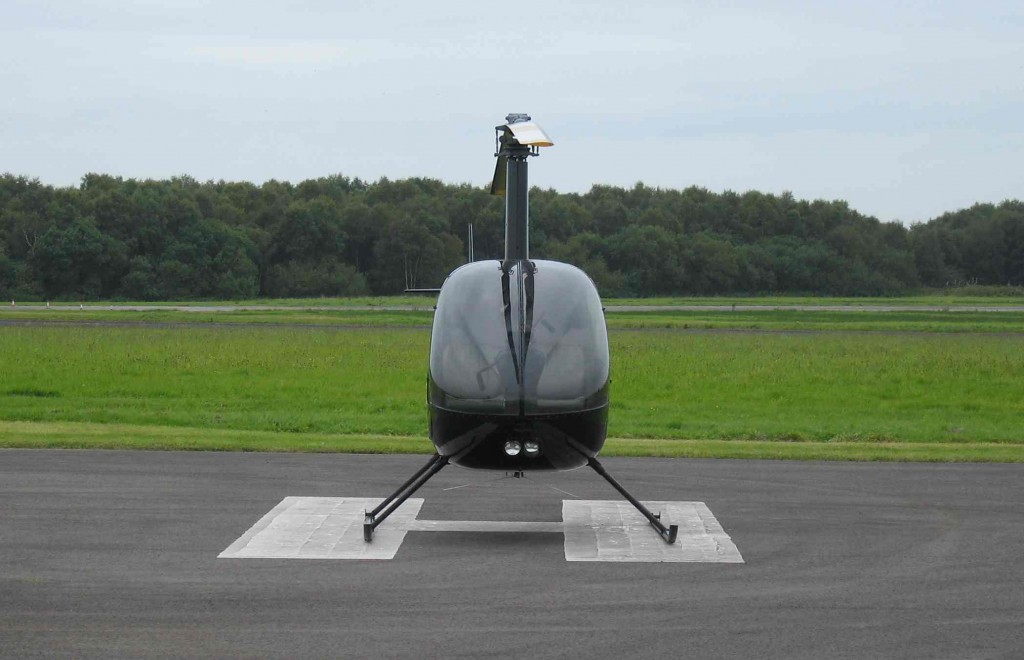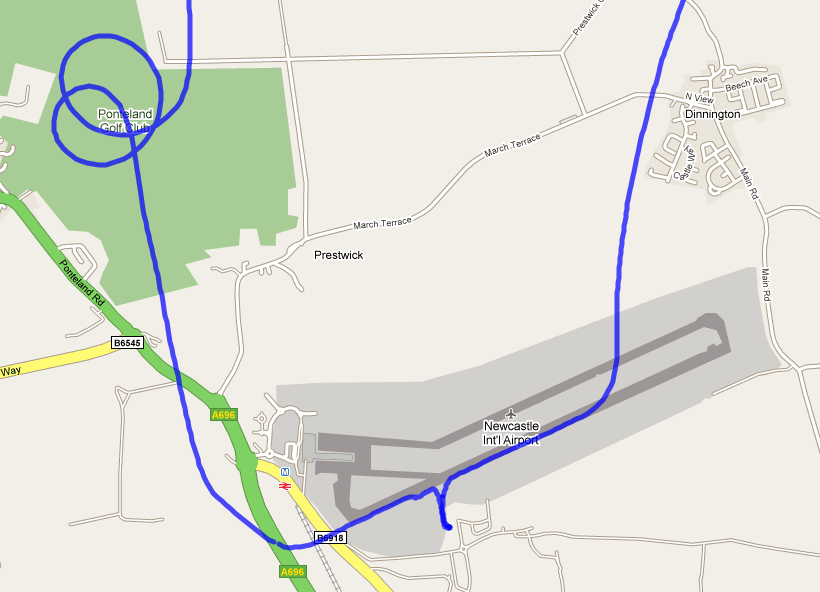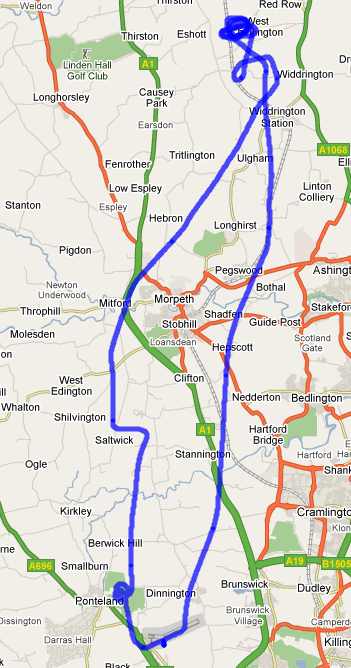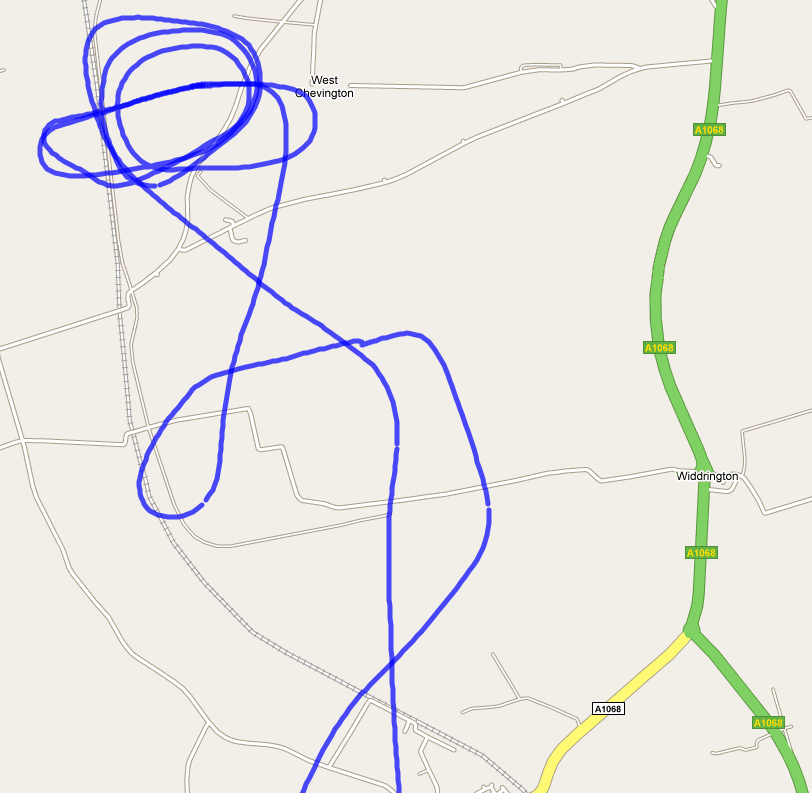Flight 32 – 18th September 2009 – 1135 – 42 minutes – Total so far – 34 hours 4 mins
Flight 33 – 18th September 2009 – 1300 – 42 minutes – Total so far – 34 hours 46 mins
Got my solo hours up today. Did a land away at Carlisle.
The weather was good. Very calm. Surface Wind variable and low. 2000 feet winds were 180′ at 10 knots.
I’d mostly plotted the route and track before I got there, leaving only the magnetic track to work out, given the spot winds.
It’s been a while since I’ve solo’ed so I was a bit anxious walking up to the heli, but as soon as I started checking her over, all my nerves disappeared and I was in the zone.
My concerns for the trip before I left were……
Being handed to Newcastle Radar and what kind of banter would be involved
Working out where to land, taxi etc at Carlisle and being able to understand them ‘cos I’ve struggled with Carlisle a few times before.
The concerns were unfounded and the R/T went swimmingly throughout to my great relief. Actually there was one cockup on the R/T but I’ll come to that. But, from an “understanding the R/T” perspective , it went great, partly, I am sure, because of the new headset. And I suspect because Steve wasn’t there, I’m more alert to everything on the radio.
So, first thing of course, was checking the HP R22 out. Steve wasn’t there when I arrived, but he’d left it fuelled and oiled and left instructions with another instructor (John) to get me on my way. John rang Carlisle to get them to expect me and I booked out from Newcastle.
The heli was good to go. I did the checks, got the first heading in my head, got permission to start, clearance and permission to taxi and I was on my way. Here was where I cocked up on the R/T. I’d set the frequency for Newcastle Radar in anticipation of being asked to switch to Radar after departure. Unfortunately, I’d forgot to switch back to Newcastle Tower, so I called Newcastle Radar asking them for my clearance. They were canny about it though. So, taxi to Foxtrot, Runway 25 departure with a right turn. The visibility was about 6 miles, so it wasn’t brilliant, but VERY flyable, just not pretty to look at.
First Leg to the north of Ponteland, very short. The HP without the extra fuel tank and with only me in it, is like a rocket ! I’d estimated 75 knots (about 86mph) in my plan, but pulling 21 MAP, it was more like 90 knots most of the time. (approx. 104 mph). So, the whole trip including startup, shutdown took 42 minutes. So probably about 30-35 minutes from Newcastle to Carlisle.So, the extra power had made up for the 10 knot crosswind and more.
The handover to Newcastle Radar went fine as did the handover to Carlisle. On the way over, I was under a Basic Service, which means I get information (if they have time) about aircraft in the vicinity. They told me about a low flying Hercules en route to Spadeadam (big military area of land). I told them I’d keep my eyes peeled. They later asked if I had a visual and told me where it should be , but I just couldn’t see it. I’m normally quite good at spotting other a/c, but to my annoyance I couldn’t see it at all. 
Shame ! 
Anyway, Carlisle was quite busy with most of the aircraft being given 07 approaches, but I was givem instructions to land on the threshold for Runway 19, which suited me better anyway. They included instructions to exit at Bravo. As I was about 600 feet on the approach, they asked me if I needed fuel. When I said I didn’t (“Negative”), they said cleared to land on the helipad. Cool !!! So, last minute diversion to the helipad, skipping over the grass. The landing was a 5/10 (still very safe, but not a kiss, more a fist in the face). It was so close to being a 10/10, but it just didn’t smooch onto the “H”. So, a dp special ensued where I played with the “H” (up and down) and in the end (about 7 seconds later), I thought of something Scott had said (“You need to commit to a landing and go for it”). So, I got it lined up with the “H”, tried for a 10/10 and missed, but then committed and we clunked down. Safe, but not pretty. But Bang on the “H” – ish!)

I shut her down and then went for coffee and a bacon sarnie. Yum !! Whilst there, I plotted my route back.
After a toilet trip, I was good to go. I checked her over again, got comfy and booked out over the radio. They gave me permission for rotor start and we were warming up.
When I was ready, I had a check of the whereabouts of Carlisle and where they may ask me to go hoping that may help my comprehension of them. But it didn’t prepare me for what they said at all.
dp :- Northumbria02 ready for taxi
Carlisle Tower :- Northumbria02, taxi towards the windsock at your 4 O’Clock position.
Strangely, I looked over my left shoulder ?! Then it dawned on me 4 O’clock is on my right.
Well, I understood what they’d said, and I could see the windsock but didn’t know what they were going to get me to do after that. But, I was happy with doing it, so….
dp:- Taxi to the Windsock, N02
As I approached the windsock, they were busy with other aircraft so I got into a nice hover. So much easier in calm winds. The windsock was very limp !!! There was no wind at all.
Carlisle Tower :- Northumbria02. With a departure to the South East, you’re cleared for takeoff.
dp :- Departing to the South East, cleared take off.
One last check. All instruments green, all the lights off. Go Go Go !!!
The flight back was uneventful. I kept checking on the map (in both directions) to make sure I was where I thought I was, but in the end, I put the GPS on, not so much because I needed it, but more because you don’t have to find your place all the time. It’s a pain taking your eyes away from flying to work out where the red track line is and then work out where you are. The GPS is just so much easier. When I did the PPL(A) many moons ago, I’m pretty sure GPS wasn’t available to civilians, certainly none of the aircraft I flew had it in. But then in a light aircraft it is easier to hold a map and fly than in a heli.
I was a bit eager when reentering the Newcastle Zone. They’d granted me permission to enter at Stagshaw about 15 miles before I got there. So I was already thinking/worrying about would they want me to do a right or left handed circuit for 25. So, once in the Zone, I said…..
dp :- Northumbria02, north abeam Stagshaw, QSY Newcastle Tower.
Which means I want to go to Tower. The sooner I knew which circuit it was and where I was joining, the happier I’d be.
Their reply….
Newcastle Radar :- N02, Are you visual with the field ?
dp :- Negative
Newcastle Radar :- Report field in sight.
That made sense. They wanted to keep me until I could see the field in case I needed directions probably.
5 minutes later, when I reported the field in sight, they handed me over and Tower gave me a right hand downwind join to 25.
I was number 3 to a Dash-8 and Lynx helicopter. I had visual with both, which is always reassuring.
The approach was great, as I was following the Lynx at about 1/2 to 3/4 mile. He went down Foxtrot, I followed him off.
Once vacated (the runway), I wasn’t sure where to park. There was no big wide spot, there was next to the Lynx and a businessman’s jet, or between the bowser and the R44. I went for the latter. It was a tight spot, but if I breathed in, I’d be fine. I knew I could do it cos the winds were so light.
It would have been nice to end on a 10/10 landing, but it was a 6/10. Again, still safe, no movement in any direction apart from down.
So, absolutely loved this flight. It had a purpose (Bacon Buttie) and was an enjoyable flight.
Nice chat with Steve on my return, before heading home with 1.4 more solo hours towards the 10 required.
![]()









